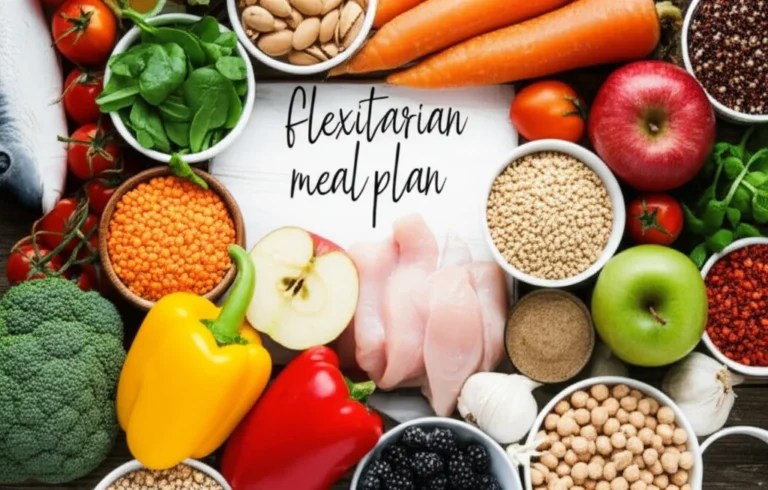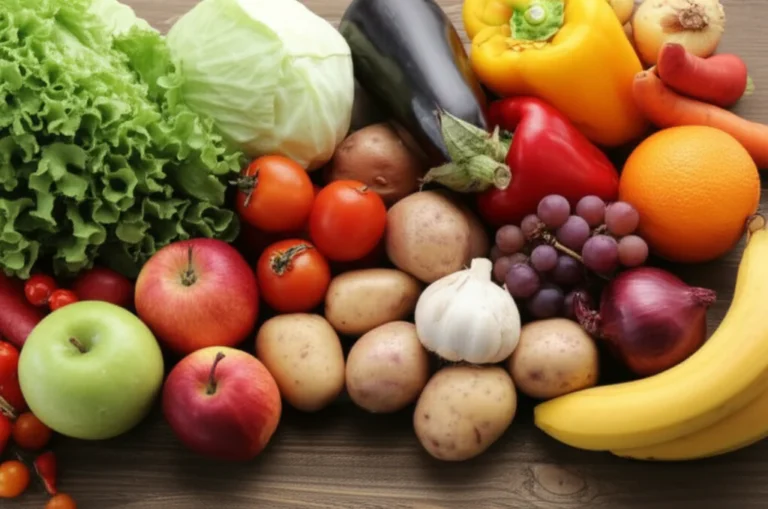Support our educational content for free when you buy through links on our site. Learn more
DASH Diet: The Ultimate Guide to a Heart-Healthy Lifestyle [2024] 💚
Quick Answer: The DASH (Dietary Approaches to Stop Hypertension) diet is a flexible and balanced eating plan that promotes a heart-healthy lifestyle. It emphasizes consuming vegetables, fruits, whole grains, lean proteins, and low-fat dairy products while limiting saturated fats, sugar-sweetened beverages, and sweets. The DASH diet has been ranked as one of the best diets for healthy eating and heart health. Let’s dive into the details and discover how the DASH diet can benefit you!
Imagine a diet that not only helps you maintain a healthy weight but also reduces your risk of developing high blood pressure and heart disease. Sounds too good to be true, right? Well, it’s not! The DASH diet, short for Dietary Approaches to Stop Hypertension, is a scientifically proven eating plan that can improve your overall health and well-being. In this comprehensive guide, we’ll explore the ins and outs of the DASH diet, its benefits, and how you can incorporate it into your lifestyle. So, let’s get started on this heart-healthy journey together!
Table of Contents
- Quick Answer
- Quick Tips and Facts
- Background: The Origins of the DASH Diet
- The Science Behind the DASH Diet
- How Does the DASH Diet Work?
- The DASH Diet in Practice
- Meal Planning on the DASH Diet
- DASH Diet and Weight Loss
- DASH Diet for Hypertension
- DASH Diet for Diabetes
- DASH Diet for Heart Health
- DASH Diet for Overall Well-being
- FAQ
- Conclusion
- Recommended Links
- Reference Links
Quick Tips and Facts
Before we dive into the details, here are some quick tips and facts about the DASH diet:
✅ The DASH diet emphasizes consuming vegetables, fruits, whole grains, lean proteins, and low-fat dairy products.
✅ It limits saturated fats, sugar-sweetened beverages, and sweets.
✅ The DASH diet is flexible and can be customized to meet your individual needs and preferences.
✅ It has been ranked as one of the best diets for healthy eating and heart health by U.S. News & World Report.
✅ The DASH diet is not a fad diet but rather a long-term eating plan that promotes overall health and well-being.
Now that you have a glimpse of what the DASH diet is all about, let’s take a deeper dive into its background and the science behind it.
Background: The Origins of the DASH Diet
The DASH diet was developed by the National Heart, Lung, and Blood Institute (NHLBI) in collaboration with other leading health organizations. Its primary goal was to create an eating plan that could effectively lower blood pressure without the need for medication. The NHLBI conducted extensive research to identify the dietary factors that contribute to hypertension and heart disease. The result was the DASH diet, which has since gained recognition for its effectiveness in promoting heart health.
The Science Behind the DASH Diet
The DASH diet is backed by solid scientific evidence. Numerous studies have shown that following the DASH eating plan can significantly reduce blood pressure and lower the risk of developing heart disease. In fact, the DASH diet has been proven to be as effective as medication in lowering blood pressure. It’s no wonder that the DASH diet has received widespread acclaim from health professionals and organizations.
How Does the DASH Diet Work?
The DASH diet works by focusing on key nutrients that have been shown to lower blood pressure. These nutrients include potassium, calcium, magnesium, fiber, and protein. By increasing your intake of these nutrients and reducing your consumption of sodium, saturated fats, and added sugars, you can effectively manage your blood pressure and improve your overall cardiovascular health.
The DASH Diet in Practice
Now that you understand the principles behind the DASH diet, let’s explore how you can put it into practice. The DASH diet is not a one-size-fits-all approach. It can be tailored to your individual needs and preferences. Here are some key guidelines to follow:
-
Increase your intake of fruits and vegetables: Aim for 4-5 servings of fruits and vegetables each day. These nutrient-rich foods are packed with vitamins, minerals, and antioxidants that promote heart health.
-
Choose whole grains: Opt for whole grains such as brown rice, quinoa, and whole wheat bread instead of refined grains. Whole grains are higher in fiber and provide more nutrients.
-
Include lean proteins: Incorporate lean proteins such as skinless poultry, fish, beans, and legumes into your meals. These protein sources are lower in saturated fats and provide essential nutrients.
-
Opt for low-fat dairy products: Choose low-fat or fat-free dairy products such as milk, yogurt, and cheese. These options are lower in saturated fats and provide calcium and other essential nutrients.
-
Limit sodium intake: Reduce your consumption of sodium by avoiding processed foods, canned soups, and fast food. Instead, season your meals with herbs, spices, and other flavor-enhancing ingredients.
-
Cut back on saturated fats and added sugars: Limit your intake of foods high in saturated fats, such as fatty meats, full-fat dairy products, and fried foods. Additionally, reduce your consumption of added sugars found in sugary beverages, sweets, and desserts.
By following these guidelines, you can create a balanced and nutritious eating plan that aligns with the principles of the DASH diet.
Meal Planning on the DASH Diet
Meal planning is an essential aspect of the DASH diet. It allows you to stay organized, make healthier choices, and ensure that you’re meeting your nutritional needs. Here are some tips to help you with meal planning on the DASH diet:
-
Plan your meals in advance: Take some time each week to plan your meals and snacks. This will help you avoid impulsive food choices and ensure that you have nutritious options readily available.
-
Include a variety of foods: Aim to incorporate a wide range of fruits, vegetables, whole grains, lean proteins, and low-fat dairy products into your meals. This will provide you with a diverse array of nutrients and flavors.
-
Experiment with new recipes: Don’t be afraid to try new recipes and experiment with different flavors and ingredients. This will keep your meals exciting and prevent boredom.
-
Prepare meals in bulk: Consider batch cooking and preparing meals in advance. This will save you time and make it easier to stick to your DASH eating plan, especially on busy days.
-
Stay hydrated: Remember to drink plenty of water throughout the day. Hydration is essential for overall health and well-being.
By incorporating these meal planning tips into your routine, you can make the DASH diet a sustainable and enjoyable part of your lifestyle.
DASH Diet and Weight Loss
While the primary focus of the DASH diet is to lower blood pressure and promote heart health, it can also be an effective tool for weight loss. The DASH diet encourages the consumption of nutrient-dense foods that are low in calories, such as fruits, vegetables, and whole grains. These foods are not only filling but also provide essential nutrients that support weight management. Additionally, the DASH diet promotes portion control and limits the intake of high-calorie, processed foods. By following the DASH diet, you can achieve sustainable weight loss while improving your overall health.
DASH Diet for Hypertension
Hypertension, or high blood pressure, is a common health condition that affects millions of people worldwide. If left unmanaged, hypertension can increase the risk of heart disease, stroke, and other serious health complications. The DASH diet has been specifically designed to help lower blood pressure and manage hypertension. By following the DASH eating plan, you can effectively reduce your blood pressure and improve your cardiovascular health. It’s important to note that the DASH diet is not a substitute for medication prescribed by your healthcare provider. If you have hypertension, it’s essential to work closely with your doctor to develop a comprehensive treatment plan.
DASH Diet for Diabetes
Diabetes is a chronic condition characterized by high blood sugar levels. It requires careful management to prevent complications and maintain overall health. The DASH diet can be a beneficial eating plan for individuals with diabetes. By focusing on whole, unprocessed foods and limiting the intake of refined carbohydrates and added sugars, the DASH diet can help stabilize blood sugar levels and improve insulin sensitivity. If you have diabetes, it’s crucial to work with a registered dietitian or healthcare provider to tailor the DASH diet to your specific needs.
DASH Diet for Heart Health
Heart disease is the leading cause of death worldwide. Adopting a heart-healthy lifestyle is essential for preventing heart disease and maintaining cardiovascular health. The DASH diet is an excellent tool for promoting heart health. By emphasizing nutrient-rich foods and limiting the intake of saturated fats, sodium, and added sugars, the DASH diet can help reduce the risk of heart disease and improve overall cardiovascular function. It’s important to note that the DASH diet is just one component of a heart-healthy lifestyle. Regular physical activity, stress management, and avoiding tobacco use are also crucial for maintaining heart health.
DASH Diet for Overall Well-being
Beyond its cardiovascular benefits, the DASH diet can improve your overall well-being. By nourishing your body with nutrient-dense foods, you’ll provide it with the essential vitamins, minerals, and antioxidants it needs to function optimally. The DASH diet can boost your energy levels, support a healthy immune system, and improve your mood. Additionally, the DASH diet promotes a balanced approach to eating, allowing you to enjoy a wide variety of foods while still prioritizing your health.
FAQ
What do you eat in the DASH diet?
On the DASH diet, you eat a variety of nutrient-rich foods, including:
- Fruits and vegetables
- Whole grains
- Lean proteins such as poultry, fish, beans, and legumes
- Low-fat or fat-free dairy products
- Nuts and seeds
- Healthy fats such as olive oil and avocado
Read more about “How Much Meat Should I Eat Per Week? …”
Are eggs on the DASH diet?
Yes, eggs can be included in the DASH diet. They are a good source of protein and can be a part of a balanced eating plan. However, it’s important to consume them in moderation and choose healthier cooking methods such as boiling or poaching instead of frying.
Are potatoes OK on the DASH diet?
Yes, potatoes can be included in the DASH diet. They are a good source of potassium and fiber. However, it’s important to prepare them in a healthy way, such as baking or boiling, and avoid adding excessive amounts of butter, sour cream, or other high-fat toppings.
Do you lose weight on the DASH diet?
The DASH diet can be an effective tool for weight loss, especially when combined with regular physical activity. By focusing on nutrient-dense foods and portion control, the DASH diet can help you achieve sustainable weight loss while improving your overall health.
Conclusion
The DASH diet is not just another fad diet; it’s a scientifically proven eating plan that promotes a heart-healthy lifestyle. By following the DASH diet, you can lower your blood pressure, reduce your risk of heart disease, and improve your overall well-being. The DASH diet is flexible, customizable, and can be tailored to your individual needs and preferences. So why wait? Start incorporating the principles of the DASH diet into your life today and reap the numerous health benefits it has to offer!
Remember, if you have any specific health concerns or medical conditions, it’s always best to consult with a healthcare professional or registered dietitian before making any significant changes to your diet.
Recommended Links
- Flexitarian Basics
- Flexitarian Lifestyle
- Flexitarian Nutrition Facts
- Benefits of Flexitarian Diet
- Myths and Facts about Flexitarian Diet
- How Much Meat Should I Eat Per Week? 2024



